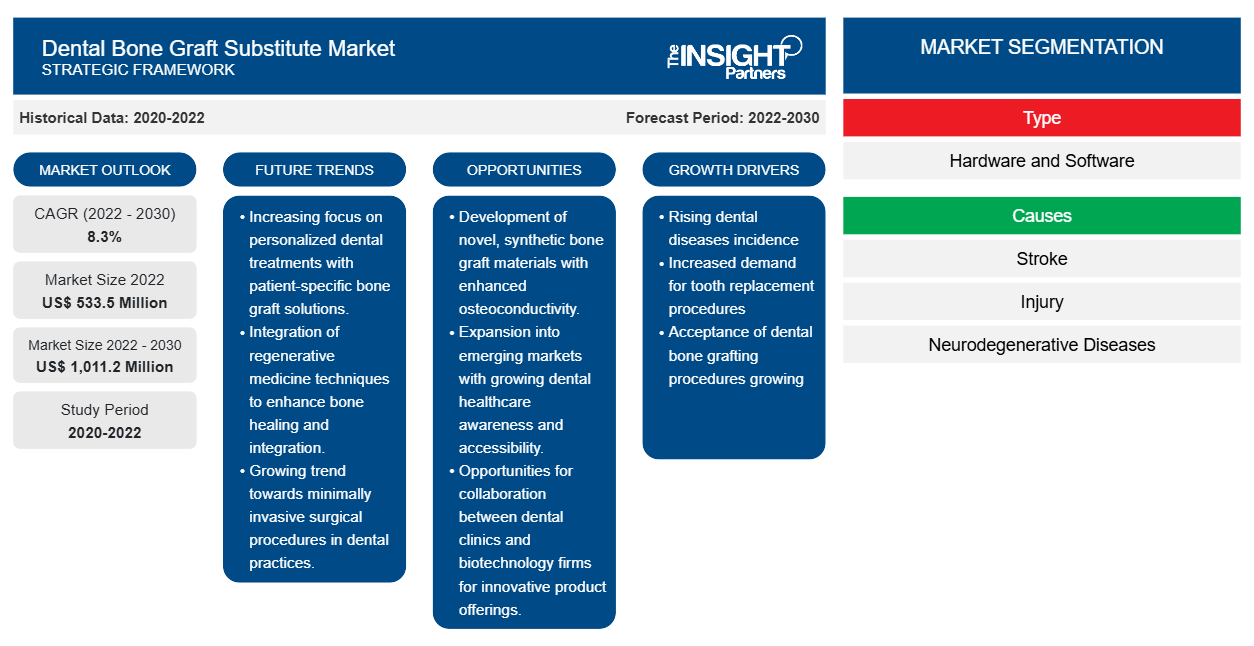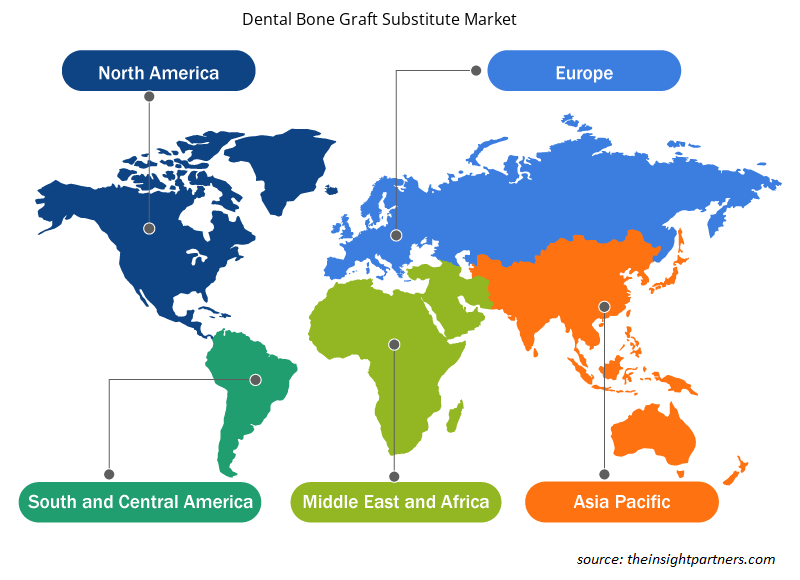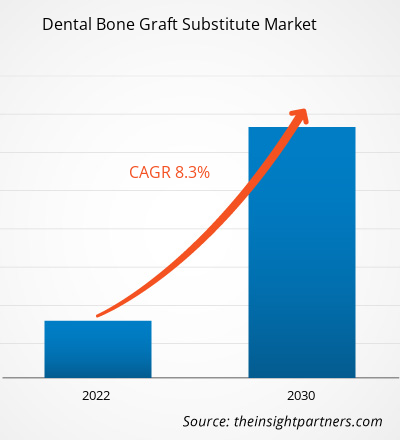[Forschungsbericht] Der Markt für zahnärztliche Knochentransplantatersatzstoffe hatte im Jahr 2024 ein Volumen von 623,20 Millionen US-Dollar und soll bis 2031 1.098,48 Millionen US-Dollar erreichen. Für den Zeitraum 2025–2031 wird eine durchschnittliche jährliche Wachstumsrate (CAGR) von 7,21 % erwartet.
Markteinblicke und Analystenansicht:
Der Markt für dentale Knochenersatzmaterialien wächst aufgrund der zunehmenden Zahl von Zahnerkrankungen und der zunehmenden Anzahl kosmetischer Eingriffe rasant. Die zunehmende Verbreitung von Zahnerkrankungen und die Einführung unterstützender staatlicher Initiativen für dentale Knochenersatzmaterialien gehören zu den nachhaltigsten Wachstumstreibern des Marktes für dentale Knochenersatzmaterialien. Diese Knochenersatzmaterialien werden auch in kosmetischen Zahnbehandlungen eingesetzt, weshalb insbesondere in Ländern mit hohem Einkommen eine erhebliche Nachfrage nach kosmetischen Eingriffen besteht.
Wachstumstreiber und Herausforderungen:
Die zunehmende Belastung durch Parodontitis und Mundhöhlenkrebs sowie die steigende Nachfrage nach zahnkosmetischen Eingriffen treiben das Wachstum des Marktes für dentalen Knochenersatz voran. Orale Erkrankungen sind weitgehend vermeidbar. Dennoch stellen diese Erkrankungen in vielen Ländern erhebliche Gesundheitsprobleme dar und beeinträchtigen die Menschen ein Leben lang. Zu den häufigsten Zahnproblemen zählen Parodontitis, Karies (Zahnfäule) und Zahnverlust. Die zunehmende Verbreitung von Zahnerkrankungen führt zu einem Bedarf an Zahnersatz, Zahnkronen , Kappen und Zahnbrücken. Laut dem Global Oral Health Status Report (2022) der Weltgesundheitsorganisation (WHO) sind weltweit etwa drei Viertel der Menschen von oralen Erkrankungen betroffen, davon leben etwa 3,5 Milliarden Menschen in Ländern mit mittlerem Einkommen. Darüber hinaus leiden weltweit etwa zwei Milliarden Menschen an Karies in den bleibenden Zähnen, und etwa 514 Millionen Kinder leiden an Karies in den Milchzähnen. Die zunehmende Verbreitung von Zahnproblemen wie schiefen Zähnen, Überbissen, Zahnlücken und Zahnengstand führt zu einer Nachfrage nach dentalem Knochenersatz zur Behandlung solcher Probleme. Laut den Centers for Disease Control and Prevention (CDC) leiden in den USA beispielsweise etwa 47,2 % der über 30-Jährigen an Parodontitis, die mit dem Alter zunimmt; und etwa 70,1 % der über 65-Jährigen litten im Jahr 2020 an Parodontitis. Diese steigende Zahl von Menschen mit Zahnerkrankungen treibt die Nachfrage nach dentalem Knochentransplantatersatz für eine einfache und schnelle Behandlung an. Daher treibt die weltweite Zunahme oraler Erkrankungen das Marktwachstum voran.
Die Digitalisierung der Zahnmedizin mit CAD/CAM-Technologie dürfte in den kommenden Jahren neue Trends auf dem Markt für dentalen Knochentransplantatersatz mit sich bringen.
Passen Sie diesen Bericht Ihren Anforderungen an
Sie erhalten kostenlos Anpassungen an jedem Bericht, einschließlich Teilen dieses Berichts oder einer Analyse auf Länderebene, eines Excel-Datenpakets sowie tolle Angebote und Rabatte für Start-ups und Universitäten
Markt für zahnärztlichen Knochentransplantatersatz: Strategische Einblicke

-
Informieren Sie sich über die wichtigsten Markttrends in diesem Bericht.Dieses KOSTENLOSE Beispiel umfasst Datenanalysen, von Markttrends bis hin zu Schätzungen und Prognosen.
Berichtssegmentierung und Umfang:
Die Marktanalyse für dentalen Knochenersatz wurde unter Berücksichtigung der folgenden Segmente, Anwendungen, Endverbraucher und geografischen Lage durchgeführt. Der Markt ist nach Typ in Autotransplantate, Allotransplantate, Xenotransplantate, synthetische Knochentransplantate und Sonstige unterteilt. Basierend auf der Anwendung ist der Markt in Alveolenkonservierung, Kieferkammaugmentation, parodontale Zahnregeneration, Knochenregeneration per Implantat und Sinuslift unterteilt. Der Markt ist nach Endverbraucher in Krankenhäuser, Zahnkliniken und Sonstige unterteilt. Geografisch ist der Umfang des Marktberichts für dentalen Knochenersatz hauptsächlich in Nordamerika (USA, Kanada und Mexiko), Europa (Spanien, Großbritannien, Deutschland, Frankreich, Italien und übriges Europa), Asien-Pazifik (Südkorea, China, Japan, Indien, Australien und übriger Asien-Pazifik-Raum), Naher Osten und Afrika (Südafrika, Saudi-Arabien, Vereinigte Arabische Emirate und übriger Naher Osten und Afrika) sowie Süd- und Mittelamerika (Brasilien, Argentinien und übriges Süd- und Mittelamerika) unterteilt.
Segmentanalyse:
Der Markt für dentale Knochenersatzmaterialien ist je nach Typ in Autotransplantate, Allotransplantate, Xenotransplantate, synthetische Knochentransplantate und andere unterteilt. Im Jahr 2022 hatte das Autotransplantat-Segment den größten Marktanteil. Es wird erwartet, dass das Xenotransplantat-Segment zwischen 2022 und 2030 die höchste durchschnittliche jährliche Wachstumsrate (CAGR) des Marktes für dentale Knochenersatzmaterialien verzeichnet. Autotransplantate werden üblicherweise aus extraoralen und intraoralen Stellen des Patienten entnommen, z. B. aus dem Unterkieferast, der Unterkiefersymphyse, dem äußeren schrägen Kieferkamm, der proximalen Ulna, dem Beckenkamm oder dem distalen Radius, da sie gute Quellen für kortikalen und spongiösen Knochen sind. Autotransplantate sind mit höheren Operationskosten verbunden und bergen erhebliche Operationsrisiken, z. B. Entzündungen, übermäßige Blutungen, Schmerzen und Infektionen, was ihre Anwendung auf kleinere Knochendefekte beschränkt. Obwohl andere Knochenersatzmaterialien routinemäßig zur Behandlung lokaler Alveolarknochendefekte und Oberkieferknochentransplantate in der Zahnmedizin eingesetzt werden, werden blockförmige autologe Transplantate nach wie vor routinemäßig zur Alveolarkammaugmentation verwendet. Autologe Transplantate sind das bevorzugte Material für komplexe Augmentationsverfahren, wie z. B. die Rekonstruktion des hinteren zahnlosen Unterkiefers, da nur wenige Knochenersatzmaterialien ein mit autologen Transplantatmaterialien vergleichbares Volumen an neu gebildetem Knochen produzieren können. Xenotransplantate sind Transplantatmaterialien, die von einer genetisch nicht verwandten Wirtsart stammen. Natürliche Knochenersatzmaterialien fördern ein verbessertes osteogenes, osteokonduktives und osteoinduktives Potenzial, indem sie ein günstiges Mikroumfeld für das Knochenwachstum schaffen. Die meisten vom Rind gewonnenen Xenotransplantate werden sterilisiert und für eine sichere Implantation in menschliches Gewebe aufbereitet. Diese Xenotransplantate können gefriergetrocknet oder demineralisiert und deproteinisiert werden. Xenotransplantate werden üblicherweise nur als kalzifizierte Matrix verteilt. Madrepore- und Millepore-Korallen werden geerntet und zu Korallengranulaten (CDG) und anderen Korallenxenotransplantaten verarbeitet. Trotz der vielversprechenden Aussichten vieler Xenotransplantatmaterialien gibt es bei der Verwendung von Xenotransplantat-Knochenersatzstoffen noch einige Einschränkungen. Dazu gehören die unterschiedliche Resorptionsrate, der Mangel an lebensfähigen Zellen und biologischen Komponenten sowie die Notwendigkeit von Gewebebehandlungsprozessen, die den Erhalt osteoinduktiver Zellen ermöglichen.
Der Markt für dentale Knochenersatzmaterialien ist nach Anwendung in die Bereiche Alveolenkonservierung, Kieferkammaugmentation, parodontale Zahnregeneration, Implantat-Knochenregeneration und Sinuslift unterteilt. Im Jahr 2022 hatte das Segment Alveolenkonservierung den größten Marktanteil und wird voraussichtlich zwischen 2022 und 2030 die höchste durchschnittliche jährliche Wachstumsrate (CAGR) verzeichnen.
Der Markt ist nach Endverbrauchern in Krankenhäuser, Zahnkliniken und andere Segmente unterteilt. Im Jahr 2022 hatte das Segment Zahnkliniken den größten Marktanteil im Bereich dentaler Knochentransplantatersatz und wird voraussichtlich zwischen 2022 und 2030 die höchste durchschnittliche jährliche Wachstumsrate (CAGR) verzeichnen.
Regionale Analyse:
Geografisch ist der Markt in Nordamerika, Europa, Asien-Pazifik, den Nahen Osten und Afrika sowie Süd- und Mittelamerika unterteilt. Nordamerika trägt am meisten zum globalen Wachstum des Marktes für dentalen Knochentransplantatersatz bei. Für den Asien-Pazifik-Raum wird für den Zeitraum 2022–2030 die höchste durchschnittliche jährliche Wachstumsrate (CAGR) auf diesem Markt prognostiziert. In den USA haben in den letzten 20 Jahren in der Zahnarztpraxis erhebliche Veränderungen stattgefunden. Laut CDC-Bericht leidet in den USA jeder vierte (26 %) Erwachsene an unbehandelter Karies. Zudem weist fast die Hälfte (~46 %) aller Erwachsenen ab 30 Jahren Anzeichen von Zahnfleischerkrankungen auf, wobei etwa 9 % der Erwachsenen von schweren Zahnfleischerkrankungen betroffen sind. Darüber hinaus bieten die technologischen Fortschritte in der Zahnmedizin zahlreiche Vorteile, die die Arbeit von Zahnärzten und Nutzern zahnärztlicher Leistungen erleichtern, deren ästhetische Ansprüche immer höher werden.
Regionale Einblicke in den Markt für zahnärztlichen Knochentransplantatersatz
Die Analysten von Insight Partners haben die regionalen Trends und Faktoren, die den Markt für dentale Knochenersatzmaterialien im Prognosezeitraum beeinflussen, ausführlich erläutert. In diesem Abschnitt werden auch die Marktsegmente und die geografische Lage für dentale Knochenersatzmaterialien in Nordamerika, Europa, Asien-Pazifik, dem Nahen Osten und Afrika sowie Süd- und Mittelamerika erläutert.

- Erhalten Sie regionale Daten zum Markt für zahnärztlichen Knochentransplantatersatz
Umfang des Marktberichts über zahnärztlichen Knochentransplantatersatz
| Berichtsattribut | Details |
|---|---|
| Marktgröße im Jahr 2024 | 623,20 Millionen US-Dollar |
| Marktgröße bis 2031 | 1.098,48 Millionen US-Dollar |
| Globale CAGR (2025 – 2031) | 7,21 % |
| Historische Daten | 2021-2023 |
| Prognosezeitraum | 2025–2031 |
| Abgedeckte Segmente |
Nach Typ
|
| Abgedeckte Regionen und Länder |
Nordamerika
|
| Marktführer und wichtige Unternehmensprofile |
|
Marktteilnehmerdichte für zahnärztlichen Knochenersatz: Auswirkungen auf die Geschäftsdynamik
Der Markt für dentale Knochenersatzmaterialien wächst rasant. Die steigende Nachfrage der Endverbraucher ist auf Faktoren wie veränderte Verbraucherpräferenzen, technologische Fortschritte und ein stärkeres Bewusstsein für die Produktvorteile zurückzuführen. Mit der steigenden Nachfrage erweitern Unternehmen ihr Angebot, entwickeln Innovationen, um den Bedürfnissen der Verbraucher gerecht zu werden, und nutzen neue Trends, was das Marktwachstum weiter ankurbelt.
Die Marktteilnehmerdichte beschreibt die Verteilung der in einem bestimmten Markt oder einer bestimmten Branche tätigen Unternehmen. Sie gibt an, wie viele Wettbewerber (Marktteilnehmer) in einem bestimmten Marktraum im Verhältnis zu dessen Größe oder Gesamtmarktwert präsent sind.
Die wichtigsten Unternehmen, die auf dem Markt für zahnärztlichen Knochentransplantatersatz tätig sind, sind:
- Dentsply Sirona Inc
- Dentium Co Ltd
- Geistlich Pharma AG
- ZimVie Inc
- Keystone Dental Inc
- Straumann Holding AG
Haftungsausschluss : Die oben aufgeführten Unternehmen sind nicht in einer bestimmten Reihenfolge aufgeführt.

- Überblick über die wichtigsten Akteure auf dem Markt für zahnärztlichen Knochentransplantatersatz
Branchenentwicklungen und zukünftige Chancen:
Die Marktprognose für dentale Knochenersatzmaterialien basiert auf verschiedenen sekundären und primären Forschungsergebnissen, darunter wichtige Unternehmenspublikationen, Verbandsdaten und Datenbanken. Strategien der wichtigsten Marktteilnehmer sind nachstehend aufgeführt:
- Im April 2023 gab ZimVie Inc. die Einführung zweier Produkte bekannt: RegenerOss CC Allograft Particulate und RegenerOss Bone Graft Plug. Mit der Einführung dieser Produkte erweitert ZimVie, Inc. sein Biomaterialportfolio zur Füllung von Extraktionsalveolen und parodontalen Defekten. Die Produkte sind in Nordamerika erhältlich.
Wettbewerbslandschaft und Schlüsselunternehmen:
Dentsply Sirona Inc., Dentium Co. Ltd., Geistlich Pharma AG, ZimVie Inc., Keystone Dental Inc., Straumann Holding AG, Medtronic Plc., BioHorizons Inc., MEDOSIS und LifeNet Health Inc. gehören zu den führenden Akteuren, die im Marktbericht für dentale Knochenersatzmaterialien porträtiert werden. Darüber hinaus wurden im Rahmen der Studie mehrere weitere Akteure untersucht und analysiert, um einen ganzheitlichen Überblick über den Markt und sein Ökosystem zu erhalten. Diese Unternehmen konzentrieren sich auf geografische Expansion und die Einführung neuer Produkte, um der wachsenden Nachfrage weltweit gerecht zu werden und ihr Produktangebot in Spezialportfolios zu erweitern. Ihre globale Präsenz ermöglicht es ihnen, einen großen Kundenstamm zu bedienen und so die Marktexpansion zu fördern.
- Historische Analyse (2 Jahre), Basisjahr, Prognose (7 Jahre) mit CAGR
- PEST- und SWOT-Analyse
- Marktgröße Wert/Volumen – Global, Regional, Land
- Branchen- und Wettbewerbslandschaft
- Excel-Datensatz
Aktuelle Berichte
Verwandte Berichte
Erfahrungsberichte
Grund zum Kauf
- Fundierte Entscheidungsfindung
- Marktdynamik verstehen
- Wettbewerbsanalyse
- Kundeneinblicke
- Marktprognosen
- Risikominimierung
- Strategische Planung
- Investitionsbegründung
- Identifizierung neuer Märkte
- Verbesserung von Marketingstrategien
- Steigerung der Betriebseffizienz
- Anpassung an regulatorische Trends






















 Kostenlose Probe anfordern für - Markt für zahnärztlichen Knochentransplantatersatz
Kostenlose Probe anfordern für - Markt für zahnärztlichen Knochentransplantatersatz